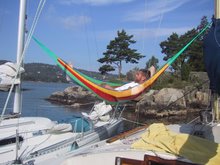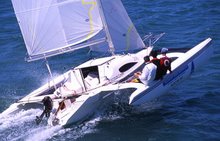I've been working on foils lately. The rudder is being wet sanded to fair the painted surface to perfection. Also, when painting, the trailing edge got rounded off instead of the intended narrow square end.
The daggerboard only had some sprayed epoxy primer on it, and I applied a thin layer of fairing compound to the whole surface. This has now been sanded back down. The kevlar-hell raised again, of course; when you sand down over a kevlar fabric and come through the overlaying epoxy/fairing compound/whatever, the kevlar fibres will instantly rise and create something similar to a brush. The only way to get this faired down again, in my experience, is to wet it in epoxy and sand it down with a very fine grit after curing. When at it, I just wiped the whole board in epoxy, and is now ready to wet sand this with a fine grit.
Finding a room where I can finish the mast has been a long time challenge. The workshop is just too short, and a heated 11m long room seems to be rare in this area. Then Guttorm offered me to use one of his chicken houses, as this had no other occupants at the moment. I could get a 3 or 4 times longer mast in there, but we closed off a corner to not have to heat the whole room. So now I have a 3,5m by 15m room with a 65 kW heater.
I took off all the hardware and removed the halyards and shrouds and then sanded the whole section. Most of it is just fine as it was made in moulds, but the join area needs some care. Also, some epoxy edges were left from the edge of the vacuum bag used for the last lamination. I follow the steps in the airplane fairing process I have linked to in the past, first filling the low areas. I will now go back and do some cheese grating when the putty is still not fully cured, and cover with the big fill.
I will not try to get a piano finish on the mast, just make sure it has the surface of a quality air foil.
Subscribe to:
Post Comments (Atom)











2 comments:
Sanding kevlar is just about impossible. On R/C model gliders with kevlar on the nose, generaly a 25 gram or 50 gram glass layer is added to overcome that problem. I'll keep it in mind when I'm going to make my rudder and daggerboard :-)
regards
Nico
I think I would have benefited on doing that. But it seems I have overcome the problem this time as well, using the method I mentioned.
Post a Comment